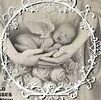When a loved one passes away, it can be comforting for their family to dress them in clothing that was part of their everyday life. Whether it’s a football shirt or comfy pyjamas, many people choose to dress their loved ones in clothing that they enjoyed wearing when they were alive – it’s an important way to remember them in the same style as they lived. And, with the rise of green funerals, more and more families are choosing to take this approach.
However, arranging a funeral can be an emotional time for everyone, and the cost of buying or making a custom outfit for their loved one can quickly add up. That’s why there are a number of organisations that specialise in creating burial gowns and wraps, allowing mourners to keep their loved one close to them while honouring their final wishes.
For example, the MOV Memorial Gowns group was set up by Nicole McAuliffe to provide free burial gowns and wraps to babies who die suddenly or prematurely. It was launched in November 2015, and the group has since been able to donate over 300 gowns and wraps to hospitals, midwives and funeral homes.
The group of volunteers meet once or twice a month to design, cut and sew gowns. They also hold fundraising events to raise money and supplies. They’re now able to offer a range of sizes and styles of burial gowns and wraps to suit every baby, from newborns through to toddlers and infants. And they’ve even created a special baby burial gown to help ease the dressing process and protect little angels weighing two to eight pounds.
They recently made their work a lot easier after Plaskolite donated acrylic for the master pattern pieces used to make the dresses and wraps. This clear material makes it easy for uniform patterns to be cut and ensures that the finished products are a true fit.
When choosing what to dress a deceased loved one in for a funeral service, it’s a good idea to consider their personality and beliefs. What did they enjoy doing? Was there anything they always wore that would reflect their interests and values? If there’s a disagreement on what they should wear, such as Grandma wanting to be dressed in her favourite baking apron and Dad insisting on his rubber waders with flies tied to them, try to come to a compromise that will help everyone understand and respect their differences.
It’s worth noting that if a person is going to be cremated, any clothing with metal or plastic (like buttons or zips) will need to be removed. And any jewellery will need to be removed before the body is prepared for cremation, as this type of soft metal can’t be recovered afterward. Fortunately, if your loved one is being buried in an open casket or a vault, they’re likely to be allowed to be fully dressed, including their jewellery and other sentimental items.
